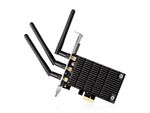TP-LINK Archer T9E
From TechInfoDepot
Jump to navigationJump to search
| abgn+ac (AC1900) | |||||
|---|---|---|---|---|---|
| AC1900 Wireless Dual Band PCI Express Adapter | |||||
 | |||||
| Homepage | Product page | ||||
| Support | Support page | ||||
| WikiDevi.wi-cat.ru | TP-LINK Archer T9E | ||||
| Wikipedia | TP-Link | ||||
| Platform | |||||
| Brand • Model • Rev | TP-LINK Archer T9E v1 | ||||
| Series | Archer T | ||||
| Interface | PCIe | ||||
| Connector | PCIe | ||||
| Form factor | single-lane | ||||
|
ID:14e4:43a0 (15 addl. devices) | |||||
|
| |||||
| FCCID | TE7T9E | ||||
|
| |||||
| Chip1 | Broadcom BCM4360 | ||||
| Antenna Connection | RP-SMA | ||||
| MIMO status | 3x3:3 | ||||
| Wireless Standards | IEEE 802.11a/b/g/n/ac | ||||
| 802.11ac | up to 1300 Mbps | ||||
| N-QAM | up to 600 Mbps | ||||
| 802.11n | up to 450 Mbps | ||||
| 802.11g | up to 54 Mbps | ||||
| 802.11b | up to 11 Mbps | ||||
| 802.11a | up to 54 Mbps | ||||
| Operating Frequency | 2.4 or 5 GHz | ||||
| Other | |||||
| Manuf/OEM/ODM | TP-LINK | ||||
Flags: | |||||
|
| |||||
|
Probable Linux driver | |||||
|
Windows driver | |||||
| Retail | |||||
| Availability | End of Life | ||||
| FCC approval date | 04 February 2015 | ||||
| EAN |
6935364080150 (UPC DB, On eBay) | ||||
| ASIN |
B00TQEX7AQ | ||||
| Country of manuf | China | ||||
| |||||
For a list of all currently documented Broadcom chipsets with specifications, see Broadcom.
For a list of all currently documented TP-LINK devices with specifications, see TP-LINK.
Overview
See also: TP-LINK Archer T series and TP-LINK
- Easy Installation - Plug the adapter into an available PCI Express slot to upgrade desktop
- Hi-Speed Wi-Fi - Up to 1.9Gbps (1300Mbps on 5GHz band or 600Mpbs on 2.4GHz band)
- 802.11ac Dual Band - 3 times faster than the 802.11n standard, perfect for network usage
- Beamforming Technology - Receives more directional Wi-Fi signals, speed and reliability
- Ultimate Range - 3 external antennas ensure a range of Wi-Fi connection and stability
- Backward Compatibility - With support for 802.11a/b/g/n standards
Pictures
See also
- TP-LINK Archer T9E - AC1900 Wireless Dual Band PCIe Adapter • PPage
- TP-LINK Archer T8E - AC1750 Wireless Dual Band PCIe Adapter • PPage
- TP-LINK Archer T6E - AC1300 Wireless Dual Band PCIe Adapter • PPage
- TP-LINK Archer T4E - AC1200 Wireless Dual Band PCIe Adapter • PPage



